1961 Italian Grand Prix race report: von Trips suffers fatal accident whilst Hill wins title
Phil Hill claims the world championship in tragic circumstances as Ferrari team-mate Wolfgang von Trips is killed in clash with Jim Clark; fourteen spectator fatalities as a result of same accident
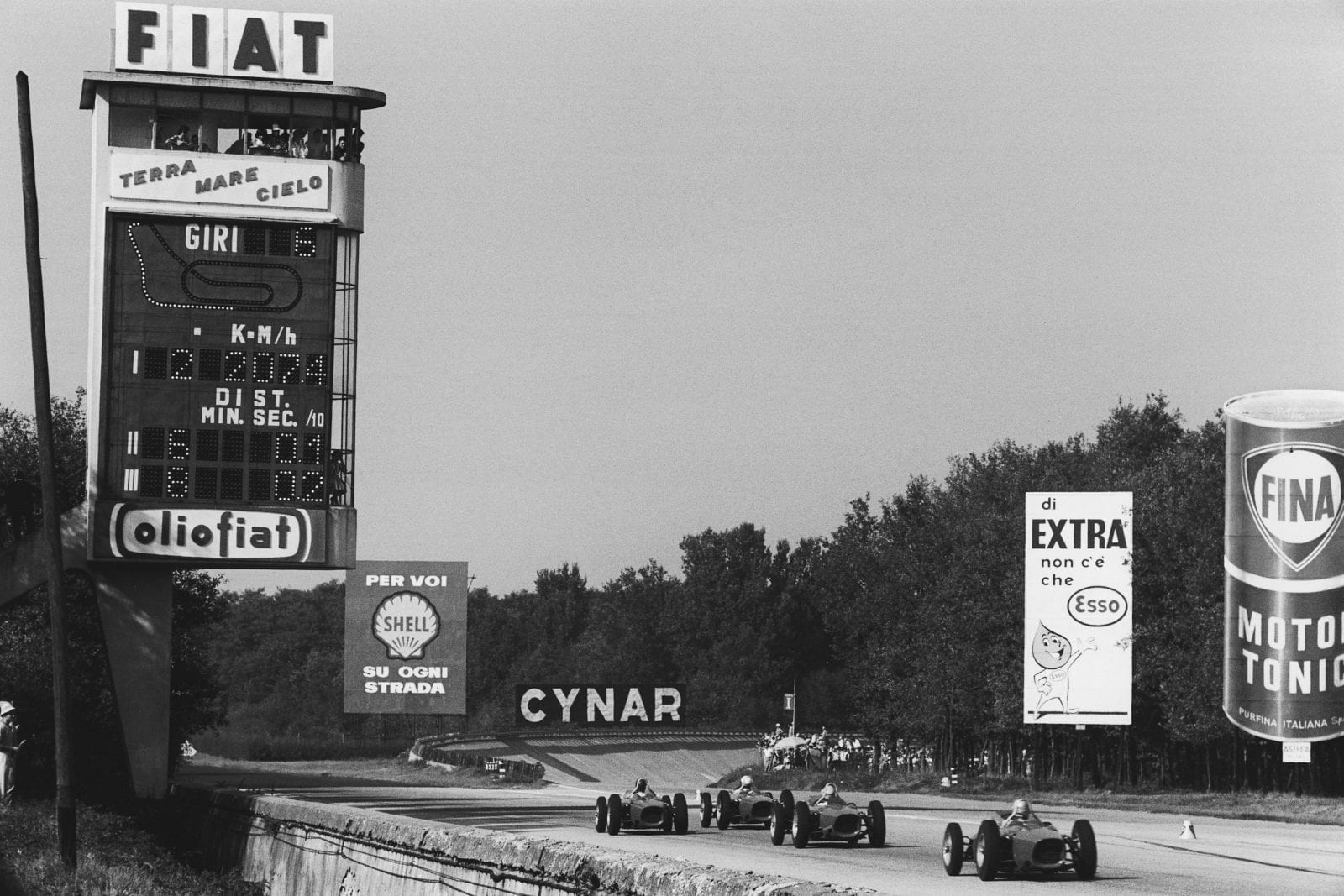
Four Ferrari Dino's 156 race down the main straight.
Motorsport Images
It is becoming traditional for the Italian Grand Prix to be considered an “end-of-season-blind”, where everyone has a go to win or burst in the attempt, for usually by September the usually various Grand Prix teams have reached their peak of seasonal development and new models are on the way, and often these are tried out in practice, the old-faithfuls being used for the race itself.
Being held at Monza, which is a pure speed track, this flat-out blind is encouraged for the Italian Grand Prix and it now seems that the combined road and banked track circuit is a permanent feature of the Monza race. The road circuit is virtually flat and very fast, even though it has three slow corners, and the speed track with its high concrete bankings is full-bore all the way round. The two are combined as shown in the accompanying diagram, with the wide straight between the pits and grandstands being divided by a row of marker cones.
To spectators in this area there is the unusual sight of ears on the pits side accelerating away from the South Turn, or “Parabolica” as it is known because of its shape, and heading for the North Banking, and cars on the grandstands side of the marker cones passing flat-out on their way to the “Curva Grande” on the road-circuit, having just come off the high-speed South Banking.

Phil Hill in a Ferrari Dino 156.
Motorsport Images
It will be recalled that last year the British teams and their drivers refused to enter the Italian Grand Prix because they considered the banked track dangerous and the race was left to the Ferrari team, the Porsche team, and a few private owners. The British had issued an ultimatum saying they would not enter unless the race was held on the road circuit only, to which the Automobile Club of Milano replied in effect with one short, sharp word, and the race was held on the combined road-track circuit without the British.
The bankings did not produce the accidents that the British prophesied and this year they all entered even though the circuit was unchanged. However, they voiced their protest well beforehand, this time in more polite terms, saving they accepted the fact that the race would be on the combined circuit, but would like it known that they would prefer the race to be on the road circuit only.
“When Enzo Ferrari gave the recent Modena race a miss, saying he was busy preparing for Monza he really meant it”
The Automobile Club of Milano were still not impressed, or even interested, and conditions were exactly as last year, except that the length of the race was shortened from 500 kilometres to 430 kilometres and anyone who did not like the track need not enter. An entry of 37 was received and this included all the factory and professional teams and nearly every private owner who could rake up a II-litre car.
When Enzo Ferrari gave the recent Modena race a miss, saying he was busy preparing for Monza he really meant it, for SEFAC Ferrari entered four cars as a works team and lent a fifth to Baghetti as a private entry. The factory team of Phil Hill, von Trips and Ginther were all on the regular cars with 120-degree engines and the fourth member of the team was young Ricardo Rodriguez, the Mexican driver, who was on an earlier car with 60-degree engine. A new 120-degree-engined car was lent to Giancarlo Baghetti and he was entered by his local Milan club, the Scuderia Sant-Ambroeus, but the Ferrari team looked after the car and the driver. As a training car for all five drivers there was the original 60-degree-engined car, with the forged front suspension wishbones, that was used for all initial testing at the beginning of this season.
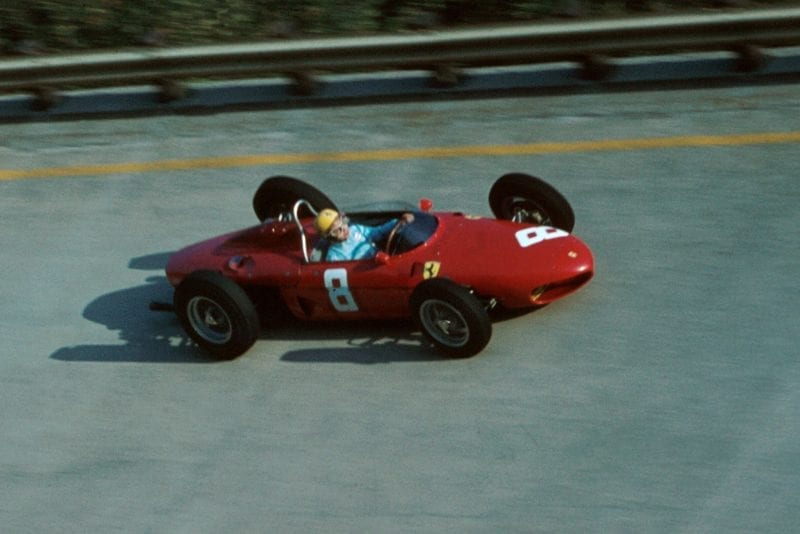
Ricardo Rodriguez pilots a Ferrari 156.
Motorsport Images
With six almost identical bright red rear-engined Ferraris lined up the Scuderia had a very impressive display. The Cooper factory had the new car with the Coventry-Climax V8 engine, as first seen at Nurburgring last month, with Brabham once again driving it, and McLaren had one of the works 4-cylinder Coventry-Climax-engined cars, while the other works one was brought along as a spare.
Team Lotus had not been able to buy a Coventry-Climax V8 engine, so Ireland and Clark were using the 1961 factory 4-cylinder cars, but the RRC Walker team had acquired a Coventry-Climax V8 and installed it in a Lotus chassis for Moss to drive. With the help of Ferguson Research, this new engine, identical to that in the works Cooper, was put into Walker’s second-string Lotus chassis. This had meant cutting off the whole of the rear part of the chassis frame, from behind the driving seat and starting again with a new layout. While doing this the 1961 rear suspension was incorporated, this being the type using a transverse strut from the top of each hub carrier to the chassis frame, thus relieving the drive shafts of all suspension loads, the old type of solid shafts giving way to normal Hardy Spicer splined shafts.
A Type 32 Colotti gearbox was attached to the Coventry-Climax engine and the new chassis frame was designed around the complete unit. This included a detachable frame-work which formed part of the rear end of the chassis and had the two top side rails integral, this whole assembly being bolted to the main frame by large bolts screwed into the ends of the tubes, which had been plugged and tapped. This structure was made from small-diameter tubing, well strutted at its corners and had to be detached completely before the engine or gearbox could be removed. Like the engine in the works Cooper this V8 Coventry-Climax used four downdraught Weber carburetters Type IDF and they were mounted in the V of the blocks.
It also had the intricate exhaust pipe layout whereby pipes from left and right cylinders were joined together so that all eight pipes had to wend their way to a junction above the clutch :lousing, from where they merged into two tail pipes sticking out of the back of the body above the gearbox. The car had been finished in a great hurry so that the old Lotus engine cover was retained, with a huge bulge added to lit over the four carburetters, the bulge on the left side for the 4-cylinder engine still being there, so that it looked a bit ungainly. The car arrived at Monza never having been tried out and the other Walker Lotus, with 4-cylinder engine, that Moss had used to win at Modena the previous week was also brought along as a training car.
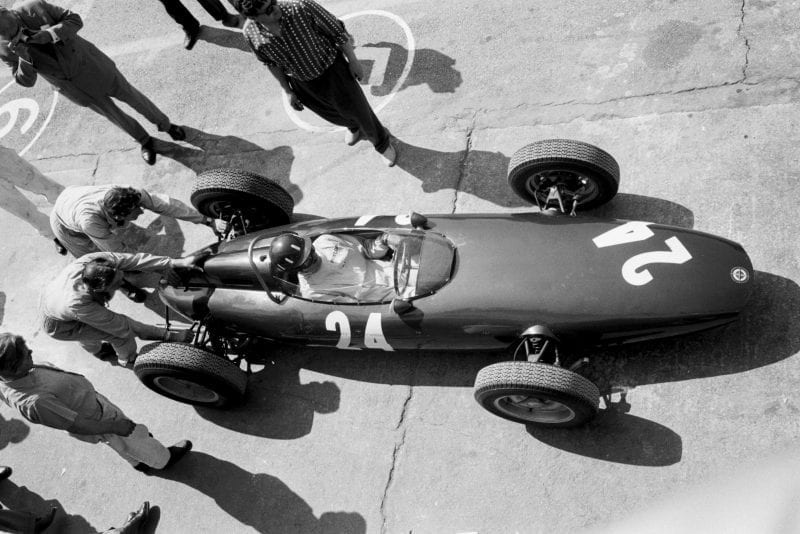
Graham Hill receives a helping hand from his mechanics in the BRM P48/57.
Motorsport Images
The BRM team had made a wonderful effort and by dint of much hard work had finished two brand new cars and arrived at Monza well before practice began with these and the two regular 4-cylinder Coventry-Climax-engined cars which had raced at Modena the previous weekend. The new cars were the V8engined ones, entirely of BRM design and brand new throughout, though suspension units and layout, and gearboxes., were as used on the 4-cylinder cars. The whole general layout and shape of these new V8-engined cars was a natural development of the proven 1960/61 cars, but a new space frame was designed to take the 90-degree V8 BRM engine.
Last April this new engine was still on the drawing board and in July parts were beginning to be manufactured and a mock-up was taking shape, and now in early September two complete cars were at Monza, the engines having done a lot of test-bed running, the cars having been tried briefly on an airfield, and a third car was nearing completion at Bourne. This was progress indeed, and before official practice for the Italian GP began on Friday the car had already been tried out on the Monza track, so much so in fact, that one of them had suffered some trouble and the other was being modified, which is the whole point of track testing. This BRM V8 engine has a large bore and short stroke, as yet unrevealed, which results in a very low and compact engine, even though a large sump is used to prevent crankcase frothing.
The cylinder blocks are at an angle of 90 degrees and each bank has two overhead camshafts driven by a gear train from the front of the crankshaft. Two valves per cylinder are used, with coil valve springs and single 10mm sparking plugs are used in each cylinder. these being supplied with sparks by a Lucas transistor ignition system, as used on the Coventry-climax V8 engine. Segments on the flywheel provide timed intervals of spark instead of make-and-break contacts and these are fed to an 8-contact distributor head driven from the gears at the front of the engine. There being no readily available Italian Weber carburetters to fit the BRM inlet port layout, and no British carburetter manufacturer being interested in making racing carburetters. a Lucas fuel-injection system is used. This is a low-pressure system injecting fuel into the inlet ports, pressure being supplied by an electric pump at around 100lb/sq-in, each cylinder having a tapered inlet trumpet.
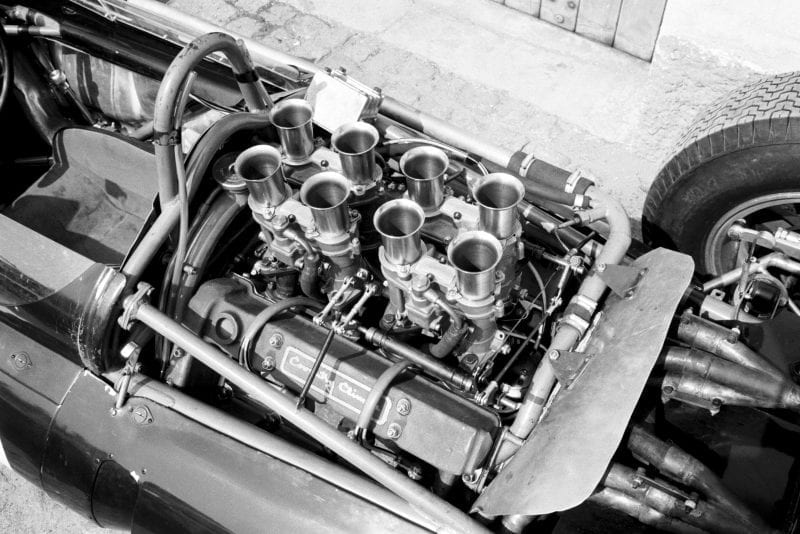
Jack Brabham’s Cooper T58 Climax V8.
Motorsport Images
This new BRM engine is very compact, tidy in its external appearance and well finished and fits so snugly into the new chassis frame tint the new cars are even lower than the 4-cylinder ones. The four exhaust pipes from each side of the engine are Yell tucked in even though they are of ” tuned lengths and merge into single tail pipes on each side, low down along side the gearbox. The bodywork is narrower than on previous BRM ears, and the nose is lower and longer and presents a very sleek outline along its whole length so that it is hard to believe that there is a VI; engine in the tail. Whereas on the Cooper and Lotus the Coventry-Climax V8 engines are obvious, for the Cars are ungainly and bulbous with signs of V8 overflowing, the BRM is the complete opposite and is so well balanced aesthetically that only the twin tail pipes show which car it is at a quick glance. The ends of the tail pipes are braced by a triangular member attached to the rear of the gearbox.
The wishbone and coil-spring suspension for all four wheels is the same as on the earlier cars and disc brakes are fitted to all four hubs; the front wheels are Dunlop alloy disc type, with knock-off hubs and the rear wheels are new alloy disc ones of BRM design, also knock-off, with very wide rims and strongly webbed between the rim and the hub.
The Owen Racing Organisation had two entries, for Graham Hill and Brooks, and which cars they would use for the race was to depend on practice results. The Porsche factory had only two entries, for Bonnier and Gurney, both using the now almost vintage 4-cylinder cars with trailing arm front suspension. As a practice and test car they had the new experimental one driven by Barth at Solitude, this having the horizontally-mounted cooling fan and the lower body line.
A third Porsche entry was the private one of the Dutchman de Beaufort, being his regular 4-cylinder car used all this season, though once again painted silver after its orange appearance at the Nurburgring. Surtees and Salvadori both had standard 1961 Cooper-Climax cars front the Yeoman Credit Team, though the former had a new experimental car to try out in practice. This was a Formula Junior Cooper chassis, which is 2 in. shorter than the Formula One chassis, fitted with Formula One suspension and brakes, and into this had been squeezed a 4-cylinder Coventry-Climax engine coupled to the latest Coloni 5-speed gearbox; this was the Type 29, which uses a different method of internal gear engagement from the original Type to and its developments, the 21 and 32. This new Yeoman Credit Special was fitted with a Formula Junior body and had been tried out briefly at Modena the previous week-end, when it had used 13in front wheels.
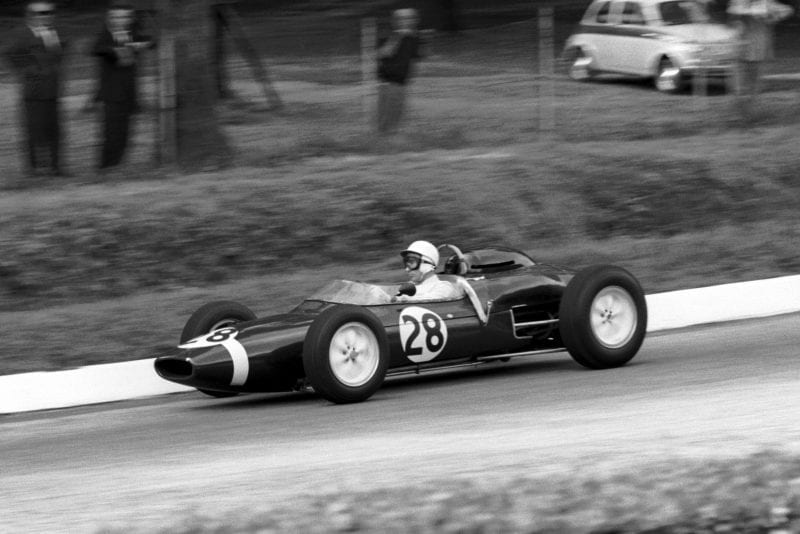
Stirling Moss in his Lotus 21.
Motorsport Images
In passing, it is interesting to note that this new car brings the Yeoman Credit team strength up to six cars. two Formula One, two special Formula One and two Inter-Continental, all Cooper-Climax. Their rival finance team, the UDT-Laystall, had three cars at Monza, though only two entries, for Masten Gregory and Henry Taylor, the formers Lotus-Climax having a new Colotti gearbox and the latter’s an original Colotti box, while all three cars had the sleeker 1961-type Lotus bodywork.
The Three Musketeers Team were there in full, Tim Parnell and Ashmore with Lotus cars and Pilette with an Emeryson, all three having Coventry-Climax engines, while Brian Naylor had a Climax in his JBW. Fairman had an old and rather tatty-looking Cooper-Climax belonging to Fred Tuck, and Seidel had one of his white Lotus-Climax cars.
The Scuderia Centro Sud entered Bandini with their 1961 Cooper-Maserati, and had Bertocchi from Maserati looking after the engine, and the Scuderia Serenissima also had his attention for the Maserati engine in their Cooper which Trintignant was down to drive. Other Maserati-engined cars were the Lotus of Starrabba and the Cooper of Pirocchi, while Boffa was entered on a Cooper-Lotus but fortunately he did not turn up for already the mind was boggling and had it actually appeared it might have been more than one could stand! To complete the list of runners there were three cars from the small Tomaso factory, one with a 1.5-litre Giulietta engine built by Conrero and having a twin-plug cylinder head, this car being driven by Vaccarella, while two others with OSCA engines were driven by Businello and Lippi.
In spite of accepting all this miscellaneous machinery and second-class drivers the club refused an entry to Jack Lewis and his 1961 Cooper-Climax, but luckily Signor Del had a spare entry for Centro-Sud and he sportingly gave this to Lewis, much to the annoyance of the Milan Club, who, having made a bungle of the entries, were not prepared to climb down.
Qualifying
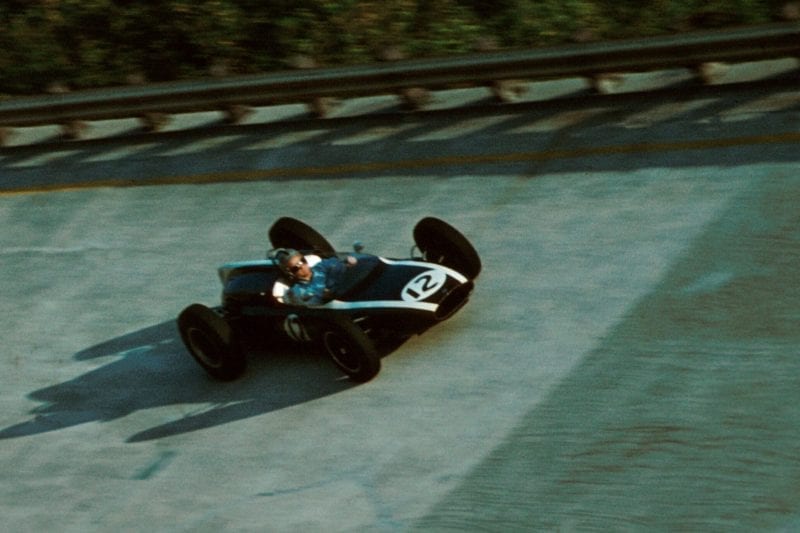
Bruce Mclaren drives his Cooper T55 around the banking.
Motorsport Images
Official practice began on Friday afternoon and went on from 3pm to 6:30pm – but before this there was a session of driving on the banked track alone for any drivers who had not competed at Monza before. Though seemingly tedious to some people this is a sensible precaution, especially for anyone who has never driven on a banked track before, and involved doing a number of laps at reasonable speeds in order to become conversant with the formation of the bankings, their height and their length.
The Ferrari team had already done a great deal of practice on the full 10-kilometre roadtrack circuit back in August and again early in the week before official practice began, and they knew that their cars were capable of lapping at 2min 46sec, which compared favourably with the lap record of 2 min though in practice last year Phil Hill had done 2min 41.4sec.
Ginther, Rodriauez and von Trips were off immediately, and the first two were soon up to a reasonable speed, Ginther with the 120-degree engine doing 2min 46.8sec and Rodriguez with the 60-degree engine doing 2min 49.6sec, and then Phil Hill joined in with a 2min 48.9sec, but at that point the rain came down. It was very gentle at first, but enough to discourage anyone from going flat-out round the banking, and then it increased and got down through the trees and made the Lesmo corners and the “parabolica” like skating rinks, so that everyone eased right up or stopped altogether.
Although the rain did not last very long and most of the track dried up quickly, there were still damp patches so that really fast laps were out of the question. Of the new British cars Moss was out with Lotus-Climax V8 and Brabham with the Cooper-Climax V8, but both were in difficulties, the Lotus with over heating troubles and the Cooper was having trouble with its water circulation round the whole system, a restriction to the flow causing water to blow out of the overflow pipe. While they were both going-they were going pretty well, and sounding terrific, the tearing scream as Moss accelerated away from the pus making people rush to the edge to sec the Lotus go by.
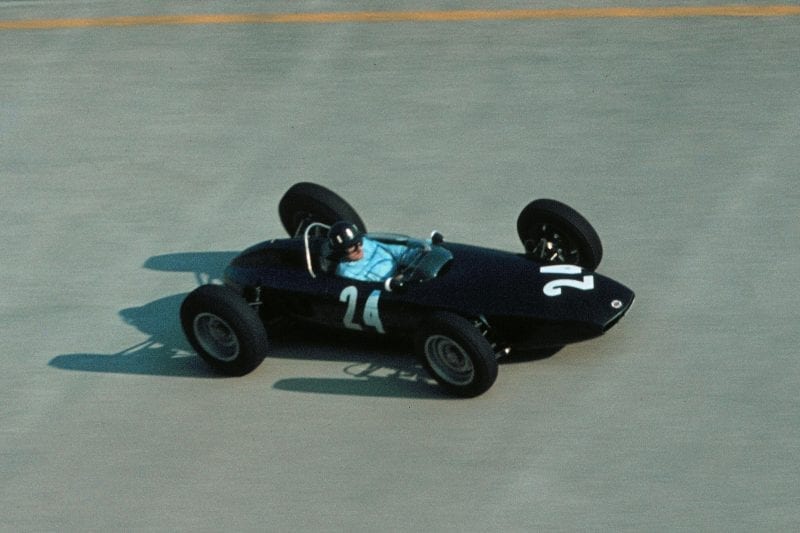
Graham Hill at the wheel of his BRM P48/57.
Motorsport Images
The new BRM was not out for this first practice, both Hill and Brooks using the 4-cylinder cars, and while one of the V8s had been damaged during testing. the other was being prepared for Saturday’s practice session. Watching on the slippery South Turn, where the surface is very smooth and where the rain had made things greasy, not being enough to wash oil and rubber off, it was fascinating to see Rodriguez waltzing round the long hairpin bend, going from lock to lock and looking quite unconcerned at the way the car was sliding, while Baghetti was looking a bit worried and trying to keep a constant Steering angle. In consequence he was sliding gradually outwards in a very gentle understeer, always managing to keep off the grass, but never looking convinced that he was going to make it.
“It was fascinating to see Rodriguez waltzing round the long hairpin bend, looking quite unconcerned at the way the car was sliding”
In sharp contrast the Tomaso cars were doing little dodges and twitches, mostly due to the inexperienced drivers. Most remarkable was Fairman in the old Cooper, who went round as if on tip-toe, at completely steady engine revs and road speed the whole way, and was faster than the Ferraris anyway. Having very little power he was able to keep things balanced, whereas a twitch of the toes in a Ferrari would release far too many horsepowers far the conditions. Towards the end of the afternoon when the whole track was virtually dry, except for the odd patch, things speeded up and it was noticeable that the Scuderia Ferrari kept both Baghetti and Rodriguez at work the whale time, either in their own cars or the training car.
That all was not well in the V8 Coventry Climax Pits was seen when Brabham came round with out any engine Covers on and Moss appeared in the Walker 4-cylinder Lotus. The works Lotus-Climax cars were going very well and Jimmy Clark was fairly singing round the banking, high up or loss down making little difference to him and on one occasion he passed underneath Barth in the experimental Porsche; the German driver being down as reserve for the Porsche Team.
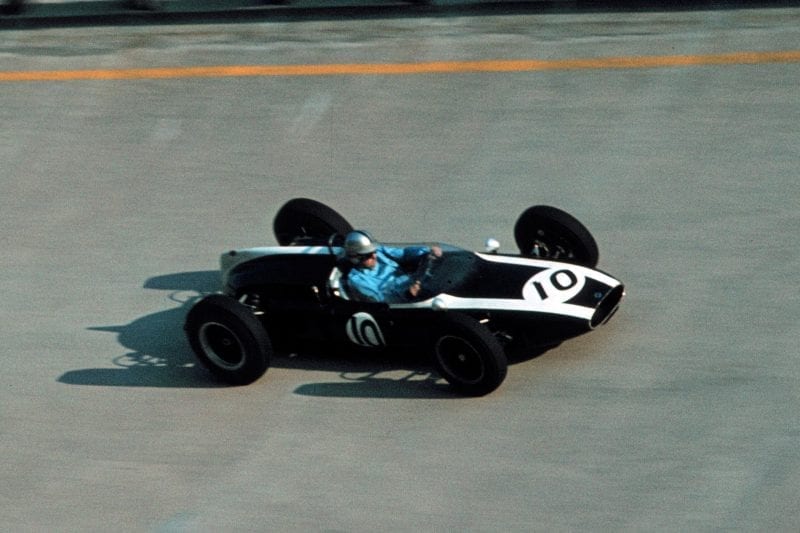
Jack Brabham in his Cooper T58.
Motorsport Images
The Yeoman Credit team were not too happy for Salvadori spent most of the time running-in a new engine, and Surtees was having trouble with both his cars, breaking the engine an the standard one. Due to the nonsense over the entry Lewis could not practice on this first afternoon and he had to sit and watch people like Pilette, Pirocchi, Businello, Parnell, Lippi and Naylor virtually creeping round.
On Saturday afternoon the sun was blazing and conditions were good, if a little too hot, and once again there was a session of banking qualification before practice began at 3pm once again, to go on until 6:30pm. The Ferrari team were out in full force and were all below 2min 50sec, which seemed to be a sort of “bogey-time”, but which was eluding most of the British cars.
The two Coventry-Climax V8-engined cars were still in cooling difficulties, the problem not being that the engine was overheating, but the circulation systems seemed to be inadequate for the rate of flow generated by the enlarged pumps of the V8s. Both Moss and Brabham did short, sharp sessions of a lap or two at a time, but were never happy and neither could go on for very long.
When they both went out without engine covers or side panels things looked bad, and became even worse when Brabham started to practise with his works 4-cylinder car. On the other hand, BRM were little better off, for after a delay in getting under way Graham Hill had not gone far before the whole thing died on him with a complete lack of sparks. He was not alone in stopping out on the circuit for a number of other competitors were in trouble and some of them had come to rest in rather dodgy places, so a halt was called while the broken-down cars were gathered in, and then practice resumed.
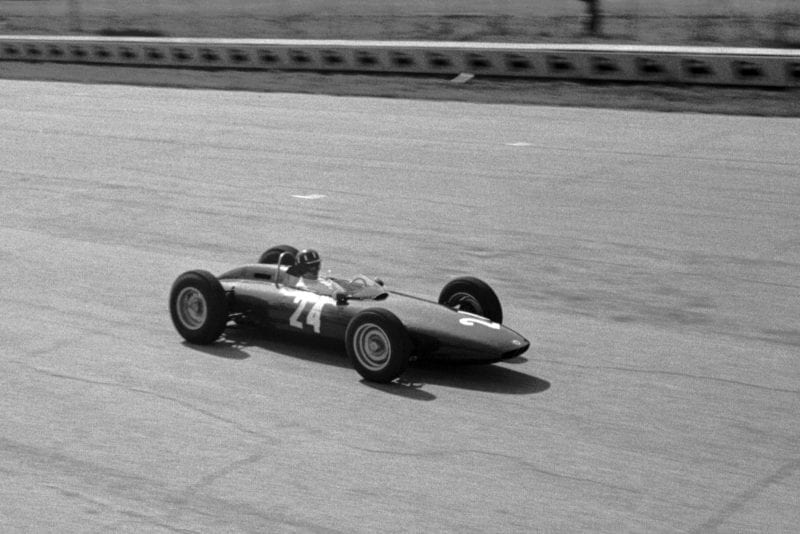
Graham Hill in his BRM P48/57.
Motorsport Images
The BRM trouble was not serious and a new distributor head and plug leads put things right. Away went Graham Hill once more and almost on a standing lisp he was clocking 2min 50sec, which was most encouraging to the BRM team, especially as the V8 Climax engines were not propelling their chassis better than 2min 51sec, although Graham Hill did not do a very great number of consecutive laps he managed one in 2min 48.7sec, which put him right among the Ferraris.
The two junior lads of the Maranello cars were still working continuously and while Baghetti was being rather cautious, Rodriguez was going like the wind, and not long after von Trips had done 2min 46.3sec with the 120-degree-engined car, the Mexican driver did 2min 46.4sec with the old 60-degree-engined car, and needless to say his “team-mates” refused point blank to believe the timekeepers! Such is team-spirit these days.
Surtees was still in trouble with the Yeoman Credit Coopers and despairing of getting any practice at all he put his numbers on the Cooper works 4-cylinder car that Brabham had been using and put in a few laps. Brooks had done a 2min 52.2sec with the 4-cylinder BRM while the UDT drivers were not really in the hunt, and like the Yeoman Credit drivers they were all put to shame by Lewis with his private Cooper-Climax, who had done 2min 54.0sec.
Team Lotus were getting on splendidly, making very little fuss, and Clark broke the “bogey-time” with a 2min 49.2sec, and Ireland came very close with 2min 50.3sec, and McLaren with the works 4-cylinder Cooper could get nowhere near them. Other good times were Bonnier with 2min 49.6sec, though for once Gurney could not match his team-mate, and de Beaufort was going surprisingly well.
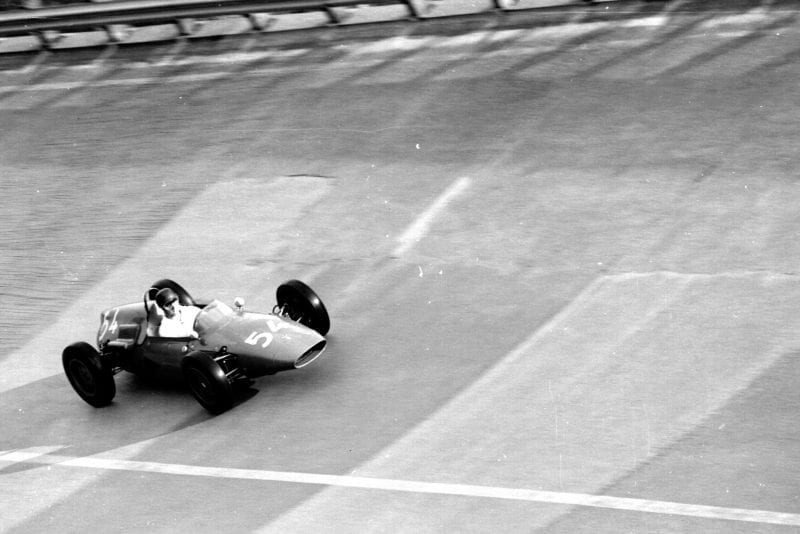
Roberto Bussinello in a De Tomaso F1/004-Alfa Romeo on the banking.
Of the miscellaneous Italians Vaccarella did a good time of 2min 56.0sec with the Conrero-engined Tomaso, beating both Bandini and Trintignant with the Maserati-engined cars. The Ferrari team, with all their drivers below 2min 50sec packed up early and went home satisfied, though Phil Hill was convinced he had a bad engine and finally talked them into putting in a new one before the race.
The V8 Climax boys were far from happy, Moss deciding not to use his V8 car, but Brabham preparing to have a go as long as the water held out, or, to be more precise, in. The BRM team were happy enough with the performance of their car, but not convinced that it was ready to race, use during practice the fuel injection had nut been spot-on and the oiling system was far from perfect, the engine leaving little pools of oil on the ground every time it stopped. While running the Bourne V8 was surprisingly quiet even though it was revving to nearly 10,000rpm and giving out the best part of 175bhp if not more, for the Coventry Climax V8 is certainly giving 170bhp. With another 12 months’ development work it is easy to visualise these new engines giving close on 200bhp, for Ferrari already has his sights on such it figure with his 120-degree V6 engine.
The regulations said that anyone who was more than slower than the second fastest practice time would be eliminated, and this rule saw only Pilette being turned down, in spite of a kit a people being unable to break the 3min for a lap.
Race
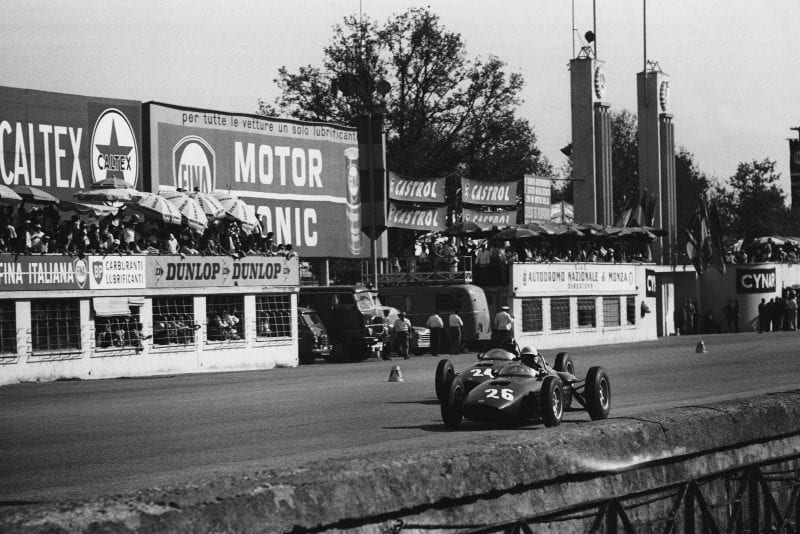
Tony Brooks in a BRM-Climax P48/57, leads Graham Hill in a BRM-Climax P48/57.
Motorsport Images
Sunday was another blazing hot day and the morning was occupied by two Gran Turismo races, each of three hours’ duration, and by mid-morning an enormous crowd had gathered round the circuit and cars, scooters, motorcycles and bicycles were still pouring into the Autodromo; to make a crowd unseen at Monza for many a year. While last-minute preparations were going on in the paddock the Lotus contingent were up to some crafty shuffling, for Moss had definitely decided against using the V8 car, and Ireland hail offered him his works car.
Behind closed garage doors the works Lotus was being bitted with the complete top of the Walker-Lotus dark blue bodywork, retaining its own dark green lower portion, and the Moss number 28 was being attached. Meanwhile, the dark blue Lotus was being fitted with the pale green top from the spare UDT car, as the works top would not fit, and Ireland’s number 38 was being affixed. Having seen the time Clark had done in practice, Ireland knew that Moss in the same car could do even better and made this sporting offer, as the Walker car was a bit tired alter its Modena race.
Both BRM drivers were on the 4-cylinder Climax-engined cars, as their V8 engine was not really ready, so once again it was only Brabham with a new engine, but he was well aware that he would not last long and everything looked set for a sweeping Ferrari victory.
With the main straight divided in two the field of 32 starters were lined up in pairs, alternate rows being staggered, and must have presented the longest Grand must Prix starting grid ever seen, The Ferraris all had their engine side panels removed and the car Moss was in received some puzzled looks as it appeared with blue top, dark greets bottom and yellow wheels.
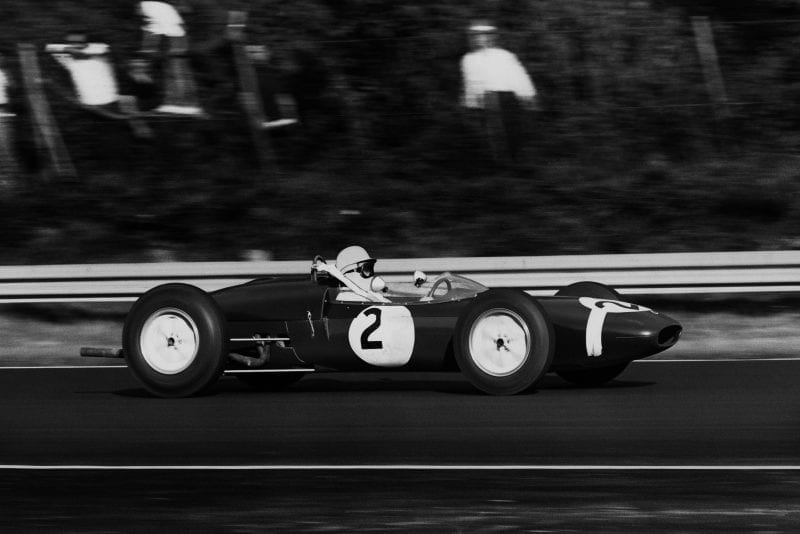
Stirling Moss in a Lotus 21-Climax.
Motorsport Images
By the 1min signal everyone had their engines running, and above the noise of blipping engines could be heard Ginther keeping his engine at a constant pitch, high up in the rev scale, and it was not until Lord Howe raised the Italian flag tor the last five seconds, that he let his revs drop and blipped the throttle in readiness for the take-otf. All the Ferraris were pulling very high axle ratios, so in consequence had very high bottom gears, and when the flag tell they seemed to hang fire for a long while before they really got under way.
As the field surged forward Graham Hill had his dark green BRM right in amongst the red cars, and Clark was leaping towards them as well. The whole 32 runners got away well and streamed round the Curva Grande and into the Lesmo bends, and as they went down the back straight, visible from the grandstands, one could sec Clark’s Lotus right amongst the red cars. Coming up the main Straight, on the pits side to head for the North Banking, Ginther and Clark were side-by-side, followed by Phil Hill, Rodriguez, von Trips, Brabham and Baghetti, with the rest in a solid stream behind.
“They were in such a tight bunch and jostling for position so continuously that a large tarpaulin really would have covered all seven cars”
Round the banking they swept, all but Ashmore who had gone into the Parabolica too fast, hit the outside grass bank and shot over it into the woods, coming off the South Banking to end the opening lap there were seven cars closer together than seemed reasonable and though they crossed the timing line in the carder Phil Hill, Ginther, Rodriguez, Clark, Brabham, von Trips and Baghetti, it meant nothing, for by the time they were into sight, the order had changed completely.
They were in such a tight bunch and jostling for position so continuously that a large tarpaulin really would have covered all seven cars. Already there was a small gap before the rest appeared, led by Bonnier, Gurney, Moss, Surtees etc, and the pace was obviously going to be fast and furious, if not a little ungentlemanly.

Dan Gurney in a Porsche 718 leads Stirling Moss.
Motorsport Images
Going down the back straight the leaders were still all bunched together, and approaching the parabolica turn, Clark and von Trips collided just before the braking point. Hill, Ginther and Rodriguez were in front of them, but Baghetti and Brabham were alongside, but luckily did not get involved.
What happened next was one of those strokes of ill-fortune that strike every so often, for the Ferrari spun and shot up the grass bank on the outside of the straight, and flung von Trips out. It cannoned off the wire mesh protecting fence and bounced back on the track, after rolling over a number of times, and stopped a crumpled wreck nearly in the middle of the track. Clark’s Lotus also spun as a result oh the impact, stayed on the track most of the time and came to rest on the grass verge, the driver badly shaken but unhurt.
The unfortunate von Trips landed heavily and though taken off to hospital died before anything could be done. The only saving grace being that he died not knowing that his Ferrari in running berserk killed 11 spectators leaning on the fence and injured many more, three of these dying later. With the whole field so close behind it was remarkable that no other cars were involved in the crash, and for those in the grandstands and pits, and around the rest of the circuit the race went on, details of the accident being unknown and unannounced by the organisers.
At the end of the second lap the order was Phil Hill, Ginther, Rodriguez, Baghetti and Brabham, with quite a gap before Moss appeared leading the two Porsches, Surtees, McLaren, the two BRMs, Ireland and Lewis. The four Ferraris up in front were not having it all their own way for Brabham was mixing it with them, the V8 Cooper-Climax being comfortably able to stay with the red care. Considering that Moss had never driven a works Lotus before, with its different handling and different gear-change, he was doing remarkably well, battling furiously with Gurney.

Dan Gurney in his Porsche 718.
Motorsport Images
Going down to the South Turn on the third lap Bonnier and Surtees collided and though the Yeoman Credit Cooper rode up and over the Porsche tail, neither car got into difficulties, though Surtees came into the pits with a damaged car and a furious temper, and Bonnier had obviously either bent something or broken something or there was a bad vibration coming Irons the back end.
Already the race had settled into groups, the leading one having Brabham stirring up the four Ferraris, with Phil Hill leading most of the time, but Ginther occasionally taking a turn, though all four red cars were so closely grouped that the actual leader was very academical. After a gap that-was widening slowly came Moss and Gurney as often as not side-by-side; and the rest of the time nose-to-tail, and they were followed at a length or two by Bonnier and McLaren.
Then came Graham Hill and Brooks, very evenly matched, with Lewis leading, all the rest, and among these de Beaufort was racing with Gregory, and Vaccarella racing with Taylor. Pit stops naturally had to be made at the end of the circuit of the road course; which was the first time up the main straight, for on the second time round the ears were on the outside. Ireland was in rabble with the Moss Lotus, being unable to select gears properly, and when he stopped at the pits it was found that the chassis was cracked, allowing flexing, so that the lever might be all right in the gear-gate, but the selector in the gearbox was out of phase.
Gregory also stopped at the pits to have the plugs changed, as he thought the car was not going properly, but the change-had no effect, so he plodded on. While the front of the field was still compact and tidy, the end was a straggling line of cars in various states of health, and one by one they dropped out.
On the ninth lap Brabham decided his engine had lost enough water and he pulled into the pits to retire before any damage was done, but he was well satisfied that that the V8 had the speed to stay with the Ferraris while it was running. With Brabham in the pits as the four Maranello cars finished the ninth lap in the order Ginther, Hill, Rodriguez and Baghetti, the race seemed over, and as there was no sign of any one of the four getting out on his own, or of any of them dropping back. It was just a question of waiting to see what “team orders” would produce.
They were comfortably 20sec ahead of the Moss/Gurney due and gaining ground all the time, lapping at around 2min 50sec. At this speed there would be no need for them to change tyres so 20sec was ample lead. For a lap or two Graham Hill had been visibly slowing and young Lewis had caught and passed him, and the reason then made itself felt when the Climax engine in the BRM blew up and Hill came into the pits to retire. Already Fairman and Naylor had gone out, and the field was thinning fast. Bonnier was the next one in trouble, the vibration getting worse, and though he stopped at the pits the trouble could not be cured and he dropped right out of the running, to eventually retire after it few more slow laps.
“Four leading Ferraris went serenely by…they could be seen going down the back straight of the road circuit, towards the scene of the ghastly accident, but then only two of them appeared out of the South Turn”
At the end of 13 laps the four leading Ferraris went serenely by, still with Ginther leading from Phil Hill, though they had reversed positions a number of times in the preceding laps, and Rodriguez and Baghetti were keeping close behind them. They could be seen going down the back straight of the road circuit, towards the scene of the ghastly accident, but then only two of them appeared out of the South Turn and come up past the pits, these being Hill and Ginther. Shortly afterwards Rodriguez came into view, heading for the pits, and the nose cowling was taken off and mechanics worked about amongst the batteries and oil tank.
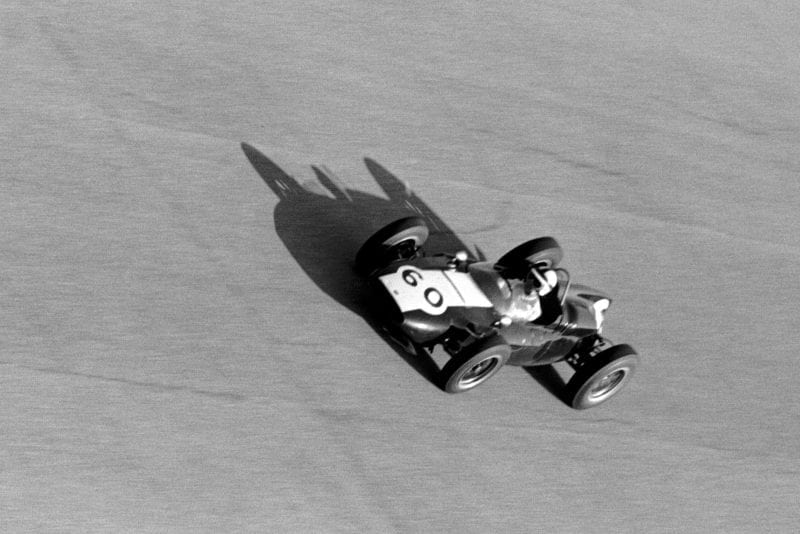
Jack Lewis scored his best ever result with a fourth place finish in his privately run Cooper T53.
Motorsport Images
Moss went past with Gurney close behind and then Baghetti appeared and also headed for the pits, and a quick look under the engine cover and number 32 was wheeled away, the engine having broken. It was not long before the Rodriguez car was wheeled away; it was .sand with fuel-pump trouble, but something more serious was suspected. This sudden change in the situation left Phil Hill and Ginther out on their own, running nose-to-tail, but consciously aware that if two cars can blow-up then four can, and they began to take things pretty easy.
They could not relax completely for Moss and Gurney were still urging each other along, passing and re-passing and all the time keeping up the pressure. Then came McLaren, followed by Brooks, Lewis, Salvadori, Trintignant, de Beaufort, Vaccarella and Bandini, the remainder being a long way back, Henry Taylor having stopped for water. Gregory abandoned his UDT – Laystall Lotus at the end of the South Banking, when a lower rear A-bracket broke its mounting, allowing the rear wheel to flop about. The two remaining Ferraris now advised down to 2min 53sec, but somehow they did not look quite so confident as at the start of the race, and with Moss and Gurney still going at it hammer-and-longs one began to wonder whether we might see another Moss victory.
The Scuderia Serenissima pit signalled to Trintignant to come in and when he stopped Count Volpi told him the sad news that von Trips was dead and suggested he might like to withdraw from the race, but the little Frenchman could see no point in such a gesture and continued on with the race, the Cooper-Maserati going quite well for once.
By half distance, as the leaders went by the pits having completed 21 laps, the order was Phil Hill, Ginther, running in formation, then Moss just leading Gurney, the two of them less than 20sec behind the Ferraris, and following at intervals came McLaren, Brooks, Lewis, Salvadori, these being the ones on the same lap as the leaders. Then came de Beaufort, Trintignant, Bandini, and Parnell, Taylor and Pirocchi way behind, these fourteen being all that was left of the thirty-two starters.
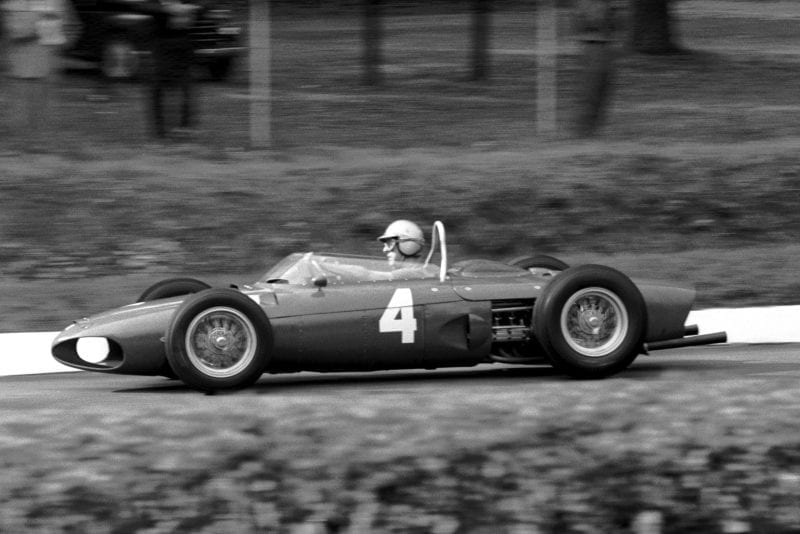
Wolfgang von trips Ferrari 156. He was involved in a horrific crash on the approach to the Parabolica that tragically killed him and fourteen spectators.
Motorsport Images
Next time round Ginther had dropped back a lot and was obviously in trouble, and on the 24th lap he drew into the pits and another Ferrari was wheeled away with a broken engine. Now a Moss victory was a distinct possibility, for the battling 1.6sec and Porsche were only the length of the main straight behind the last remaining Ferrari, and Moss was leading Gurney more often than not now, clearly having got the measure of the Porsche driver.
As a rather lonely and worried Phil Hill went into the Curve Grande, Moss and Gurney were hurtling off the South Banking, and the gap was hovering around 20sec still. McLaren was running a lonely race Ian Brooks was beginning to get glimpses of young Lewis in the mirrors of his BRM, for the young man from Stroud was keeping up a very steady pace, driving immaculately, and slowly but surely gaining on the BRM, his Cooper-Climax sounding perfect.
“The only encouragement that Phil Hill had was the knowledge that his car had a new engine, not stressed by practising”
The only encouragement that Phil Hill had was the knowledge that his car had a new engine, not stressed by practising, and he gradually speeded up and increased his lead to 28sec by the 3rd lap, in which time Lewishad come within 10sec of Brooks and was whittling this down relentlessly; equally, a lap behind Bandini was slowly but surely catching de Beaufort. Now it seemed that something was going wrong with the works Lotus, for Moss no longer led Gurney, though he was keeping just behind him, but on the 37th lap Moss drew into the pits and was forced to retire, for the left front-wheel bearing had given up and the wheel was flopping about on the stub axle. The continual leaning on this the outside wheel round all the right-hand corners and both bankings had been too much and the rollers had broken up.
For the first time since the start Gurney found himself on his own, and the 1961 Italian Grand Prix had two American drivers in full command once again, though this time on different cars. With the Ferrari pits keeping their fingers crossed, but sad in the knowledge of the death of von Trips, the leading Ferrari continued on its way, reeling off the remaining laps without a falter from its engine, or the sign of a mistake by its driver, while Gurney followed, secure in second place. By now Bandini had caught de Beaufort and passed him, but the big Dutchman seemed to wake up and promptly re-passed, the two a them then having a terrific scrap.
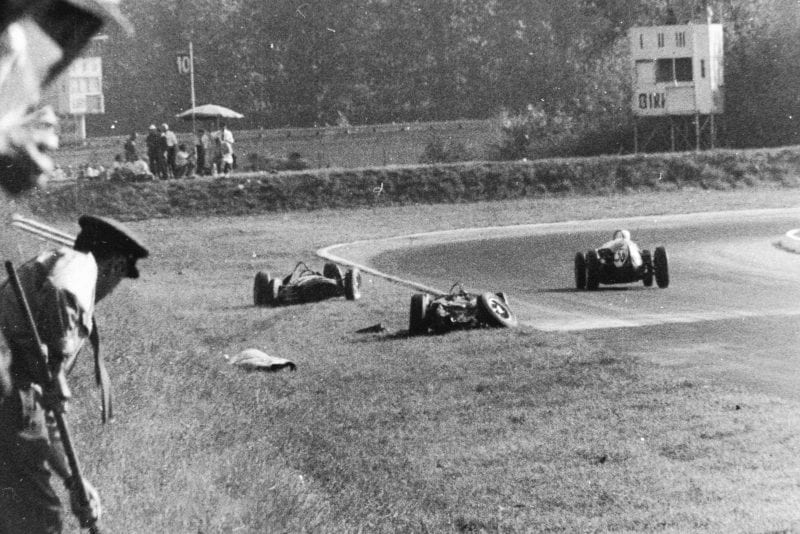
The aftermath of the accident between Wolfgang von Trips (Ferrari Dino 156) and Jim Clark (Lotus 21-Climax). Von Trips suffered fatal injuries in the accident.
Motorsport Images
On lap 40 Lewis was right behind Brooks, and the next time round be was in front but only by inches, and the BRM became glued to the tail of the Cooper, Phil Hill passed the pits for the last time and then went round the two banked turns and tip the final straight to receive a very welcome chequered flag. This was his second Italian Grand Prix win in succession, and the points gained made him unassailable World Champion, but not a happy one when he stopped and heard about the second lap tragedy.
Gurney was flagged into second place, with McLaren safely third, but the issue for fourth place was still open. On the banking for the last time could he seen the Cooper with the BRM almost touching its tail and as they came up the straight towards the finish Brooks pulled out of the slipstream as it 16 go by on the right, then changed his mind and pulled over to the left, crossing the line almost in a dead heat, but the-judges gave Lewis the verdict by-a matter of inches, placing him a most well deserved fourth, which must have made the organisers go away and eat humble-pie. A lap in arrears came Salvadori and two laps behind de Beaufort just led Bandini across the line, there being four more runners, making a total of 12 finishers out of 32 starters in what had been a hard and ruthless race.
‘There was little joy in the Ferrari team over Hill’s victory, for it was tainted with sad memories of a serious catastrophe, most unfortunate, but quite unforesecable.
MONZA MATTERS
- The unfortunate circumstances which found Phil Hill as unassailable World Champion for 1961 shrouded most of the glory.
- A number of irresponsible and mischief-making daily paper journalist said in their reports that the catastrophe happened on the part or the track leading towards the South Banking. Some of them going so far as to suggest the banking was to blame. Nothing could-be further from the truth. If the Guild of Motoring Writers have any power, at all, these irresponsible people should be severely reprimanded.
- The Italian National papers, and others, carried screaming headlines, as can be imagined, but the effect was rather stemmed by the air crash of a DC8 which killed 68 people, followed the day after by a Caravelle which killed 77 people. It is difficult to keep a sense of proportion.
- Full marks go to Ferruccio Bernabo for his sound and reasoned report and summing up or the Monza tragedy in La Stampa, a powerful Milan newspaper. On a brighter note, the new British V8 engines looked promising. ail they need is-some serious track testing, but both BRM and Coventry-Climax must have learnt a lot from what running they did during the meeting.
- After driving the Monza banking in a D-type Jaguar, in the Monza 500 Miles Race, Masten Gregory found the UDT Lotus rather dull. Having watched the Jaguar on that occasion it is easy to see what he means!
- With American drivers finishing first and second in the race, a hot M Americans must be thinking it is time these Chaps had mn American Grand Prix car with which to race.
- A new and strict rule kept all photographers and hangers-on from the area in front of the pits; for once the Press and Public could actually see what was happening during a pit stop.
